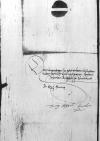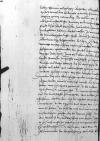Aus zuvorsichtigem vertrawen / fuegen wir Euer Lieb wissendt, / das uns ⌊konigliche wirt zu Demarcken⌋ etc., unser freuntlicher lieber herr ohem und schwager, / dieser tag bey unserm diener ⌊Frantzen Rauttern⌋ fur wharhafftigk unnd warnungsweÿss zugeschrieben, / das der ⌊konnig zu Schweden⌋ ÿtzo uf einem seiner heuser gnandt ⌊Elssburgk⌋ vier meil von dem schlos ⌊Warnbergk⌋ uf ⌊Schonen⌋ eigener person liegen, / solle auch alle sein kriegsvolgk des orts zu sich bescheiden, / dartzu etlich gross geschuetz uf zwu meil wegs nach solchem haus Elssburgk in ein kirch brengen und deselbst stehen und vorschlissen haben lassen. /
Dagegen und nichts weniger auf ein fursorg, / so hab ⌊koniglicher wirt zu Denmarcken⌋ ein anczal fuessknecht in die vestesten stedt, / welche dieselb an den schwedischen grenitzen hat, / vorseczt / etc. Hirneben ist uns fur gewiss angetzeigt, / das bemelte ⌊konnigliche wirt zu Schweden⌋ / etc. unnd ⌊Leifflant⌋ in voreÿnigung stehen unnd ire gewiese anschlege auch angriff / (das der liebe Got mit gnaden abwenden wolle) auf ⌊Denmarcken⌋ und diese landt gericht haben sollenn etc.
Dieweil aber die hendel also und dermassen, wie berurth, / sorglichen stehen / und alle ding in guether acht und aufmercklung zu haben hoch von notten, / auch an diesem krigischem vornhemen ⌊koniglicher maiestet zu Polan⌋ etc., unserm gnedigen hern und freuntlichen lieben ohemen, / vil gelegen, / derhalben allenthalben unsers ermessens beiderseÿts getrewer zuammenseczung ganncz notwendig. / So wollen wir Euer Lieb als eÿnenn christlichen prelaten und ansehenlichen gliedt disser landt ⌊Preussen⌋, / freuntlich erinnert unnd gebetten habenn, / dieselb wolle / in anmerck... der unvorbeÿgehenlichen ehafft / durch ir vleissig sollicitiren beÿ hochgemelter / ⌊koniglicher maiesteten zu Polan⌋, vermöge unsers vhesten wolmeÿnenden und offtbescheenem gutduncken den handel dohin richte[n], das von irer maiesteten inns erst allen stenden disse... landt ⌊Preussen⌋ in guether rethschafft zu sitzenn bevolhen, / und dartzu getracht, / das die befestigung der hewser und stedte / mit nodturfftiger provision unnd anderer zubehorungen vorsehen werden mochte[n].
Daneben das mit konniglichen gnaden etlichen pre[us]sischen stenden bevelch auferlegt wurde, / die do ma... hetten, / wan sich ethwas geferlichs / in des andern theils Preussen ereugen thet, / in namen seiner ⌊koniglichen maiestet⌋ die landtschafft zuvorpotten, / dem andern zu helffenn, / desgleichen, / das die vhesten heupt und amptleuth in der ⌊Masaw⌋ und ⌊Coÿen⌋ von seiner koniglichen m[aiestet] bevelch hetten, / im falh der noch und auf ansuchen auch entsetzen hulffen, / bis uf verner hilff, / dan dem veind ist unsers vorsehens am besten, / wan er sich noch nicht in befestigung eingewurckt, / zu widderstehen. / So besorgen wir uns, das sich niemants der beipflichtung / und solchs hoh[en] ampts ane seine ⌊koniglichee maiestet⌋ bevelch understehen mocht. / Zu dem ob nicht guth, / woe wir, / wie die ÿtzigen anschlege geben aus ⌊Leifflandt⌋, (do Got vor seÿ) durch eÿgene odder zugeschigkte macht ubertzogen, / das von seiner koniglichen maiesteten neben der gegenwher verardent wurde, / aus dem ⌊Grosfurstenthumb Littauen⌋ widderumb in ⌊Eÿfflandt⌋ zufallenn, / dardurch die ⌊Leifflender⌋ geursacht / ⌊Preussen⌋ zuverlassen, / und ir eigen landt zu retten. / Letzlichen solchs alles wie wir dan an Euer Lieb und der hohen nodturfft nach gar nicht zweiffeln beÿ den ⌊hern koniglichen rethen⌋ und ⌊stenden⌋ ⌊Preussisch theils⌋, / damit es umb sovil dester ehr seinen vortgang erreichen mocht underpawen verfurdern unnd fortstellen helffenn. /
Das sein wir umb Euer Lieb mit allem freuntlichen nachbarlichen willen zuvordienen geneÿgtt, / und thun Euer Lieb hiemit dem almechtigen Got in landwiriger gesuntheit und fridlichem regiment zuerhalten bevelhenn.



